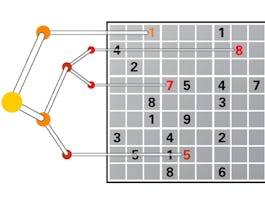Optimization is a common form of decision making, and is ubiquitous in our society. Its applications range from solving Sudoku puzzles to arranging seating in a wedding banquet. The same technology can schedule planes and their crews, coordinate the production of steel, and organize the transportation of iron ore from the mines to the ports. Good decisions in manpower and material resources management also allow corporations to improve profit by millions of dollars. Similar problems also underpin much of our daily lives and are part of determining daily delivery routes for packages, making school timetables, and delivering power to our homes. Despite their fundamental importance, all of these problems are a nightmare to solve using traditional undergraduate computer science methods.


Basic Modeling for Discrete Optimization
Taught in English
26,623 already enrolled
Course
Gain insight into a topic and learn the fundamentals


Instructors: Prof. Peter James Stuckey
Top Instructor
(439 reviews)
Details to know

Add to your LinkedIn profile
See how employees at top companies are mastering in-demand skills


Earn a career certificate
Add this credential to your LinkedIn profile, resume, or CV
Share it on social media and in your performance review

There are 4 modules in this course
In this first module, you will learn the basics of MiniZinc, a high-level modeling language for discrete optimization problems. Combining the simplicity of MiniZinc with the power of open-source industrial solving technologies, you will learn how to solve applications such as knapsack problems, graph coloring, production planning and tricky Cryptarithm puzzles, with great ease.
What's included
19 videos7 readings1 programming assignment
In this module, you will learn how to model problems involving set selection. In particular, you will see different ways of representing set variables when the variable has no constraints on its cardinality, has fixed cardinality and bounded cardinality. You also have to ensure all model decisions are valid decisions, and each valid decision corresponds to exactly one model decision.
What's included
6 videos1 reading1 programming assignment
In this module, you will learn how to model pure assignment problems and partition problems, which are functions in disguise. These problems find applications in rostering and constrained clustering. In terms of modeling techniques, you will see the power of common subexpression elimination and intermediate variables, and encounter the global cardinality constraint for the first time. MiniZinc also provides constraints for removing value symmetries.
What's included
7 videos1 reading1 programming assignment
In the final module of this course you will see how discrete optimization problems can often be seen from multiple viewpoints, and modeled completely differently from each viewpoint. Each viewpoint may have strengths and weaknesses, and indeed the different models can be combined to help each other.
What's included
6 videos2 readings1 programming assignment
Instructors

Recommended if you're interested in Software Development

The University of Melbourne

The Chinese University of Hong Kong

The Chinese University of Hong Kong

The University of Melbourne
Why people choose Coursera for their career




Learner reviews
Showing 3 of 439
439 reviews
- 5 stars
85.90%
- 4 stars
11.81%
- 3 stars
1.59%
- 2 stars
0.22%
- 1 star
0.45%
New to Software Development? Start here.

Open new doors with Coursera Plus
Unlimited access to 7,000+ world-class courses, hands-on projects, and job-ready certificate programs - all included in your subscription
Advance your career with an online degree
Earn a degree from world-class universities - 100% online
Join over 3,400 global companies that choose Coursera for Business
Upskill your employees to excel in the digital economy
Frequently asked questions
Access to lectures and assignments depends on your type of enrollment. If you take a course in audit mode, you will be able to see most course materials for free. To access graded assignments and to earn a Certificate, you will need to purchase the Certificate experience, during or after your audit. If you don't see the audit option:
The course may not offer an audit option. You can try a Free Trial instead, or apply for Financial Aid.
The course may offer 'Full Course, No Certificate' instead. This option lets you see all course materials, submit required assessments, and get a final grade. This also means that you will not be able to purchase a Certificate experience.
When you enroll in the course, you get access to all of the courses in the Specialization, and you earn a certificate when you complete the work. Your electronic Certificate will be added to your Accomplishments page - from there, you can print your Certificate or add it to your LinkedIn profile. If you only want to read and view the course content, you can audit the course for free.
If you subscribed, you get a 7-day free trial during which you can cancel at no penalty. After that, we don’t give refunds, but you can cancel your subscription at any time. See our full refund policy.




